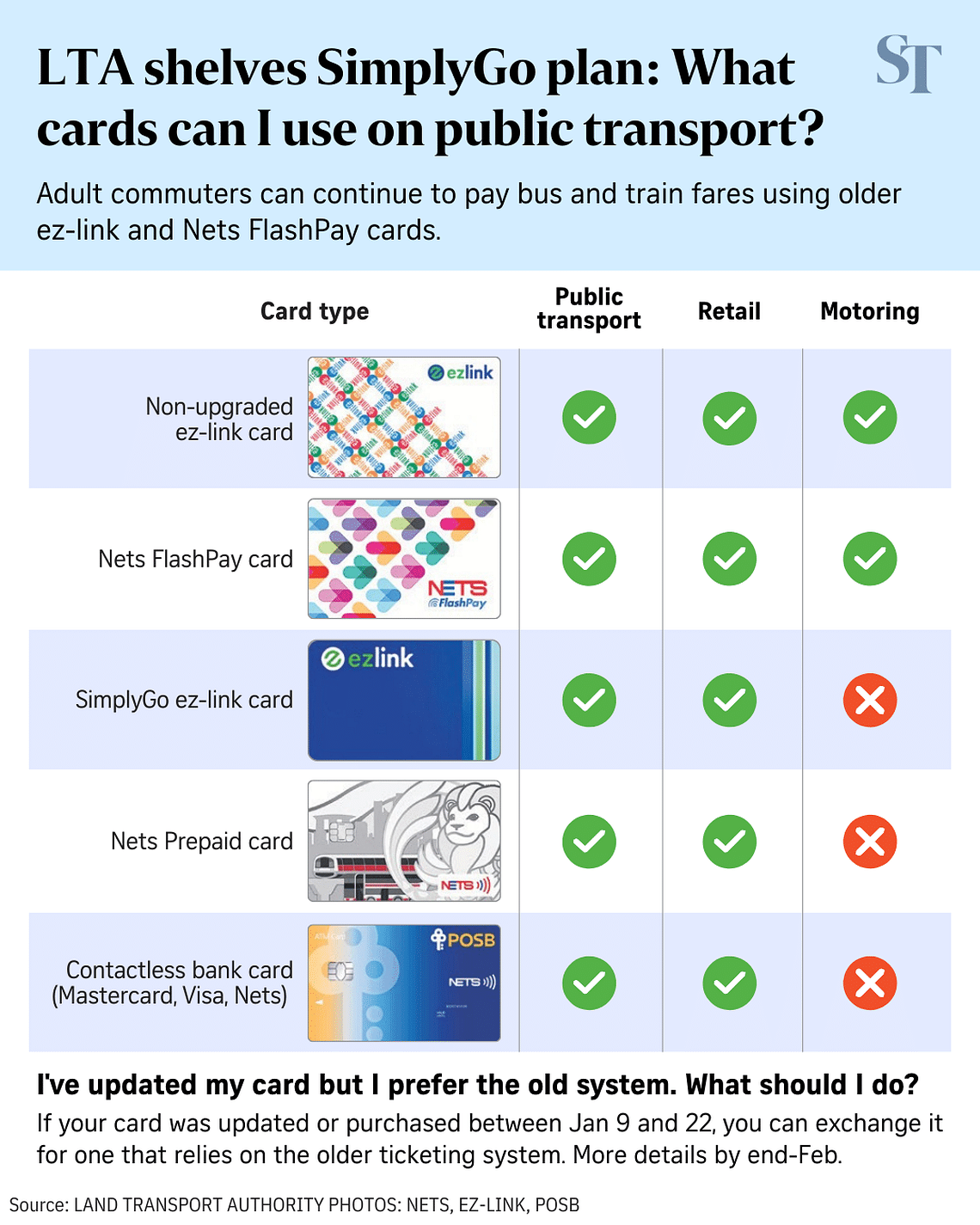Phasing out older payment cards in SimplyGo switch a ‘judgment error’, says Transport Minister
Transport Minister Chee Hong Tat said the authorities will learn from the SimplyGo issue and do better in future. ST PHOTO: LIM YAOHUI
Esther Loi and
Lee Nian Tjoe
FEB 13, 2024
SINGAPORE - The authorities made a “judgment error” in
deciding to phase out older public transport payment cards for adults, and underestimated how commuters wanted to continue seeing fare information and card balances, said Transport Minister Chee Hong Tat.
“I apologise to our commuters for what happened,” said Mr Chee in an interview with reporters on Jan 26. “We will learn from this and we will do better in future.”
The Land Transport Authority (LTA) had announced on Jan 9 that it would retire the older card-based ticketing system – which ez-link and Nets FlashPay cards run on – by June 1. These cards were to be replaced by SimplyGo, an account-based system that processes fare payments at the back end, unlike the older system of storing transaction data on cards.
But the announcement was met with an outcry from passengers, who expressed frustration about their
inability to see fare deductions and card balances when tapping out. Some who tried upgrading their ez-link cards on Jan 10 also faced delays due to a surge in transaction volume.
On Jan 22, Mr Chee said the Government
will spend an additional $40 million to extend the lifespan of the card-based ticketing system and allow passengers to continue using the older payment cards.
Speaking to the media on Jan 26, he acknowledged that the LTA had underestimated the strong preference of some commuters who wanted to continue viewing fare deductions and card balances at fare gates and card readers.
“We understand your feedback and concerns. We respect your preferences. We want to give you this option to continue to be able to choose which system best meets your needs,” he added.
Mr Chee said LTA had consulted more than 1,000 commuters from 2020 to 2023 about SimplyGo.
LTA decided to retain the concession card system after receiving feedback from seniors, and placed machines at bus interchanges and MRT stations to make it easier for commuters to check their fare transactions and card balances without using the SimplyGo app, he noted.
“If we had consulted more widely, and gathered views from a wider group of commuters before we made the decision... we would have come across the stronger reactions and preferences that some commuters had expressed,” he said.
Asked if there is an optimal number of people to consult for such policies, Mr Chee said his ministry is reviewing this.
There is no fixed number to get a representative range of views, he said, adding that in hindsight, it would have been useful for the Government to hear a wider range of views and concerns on certain issues such as SimplyGo, which affects many people.
The additional $40 million will allow the card-based ticketing system to run till at least 2030.
LTA had previously said that fare deductions and card balances are not displayed at fare gates for payment cards under SimplyGo, as it takes a few seconds to retrieve the information from SimplyGo’s back-end system. This will slow the entry and exit of passengers and result in longer queues.
Mr Chee said he has tasked LTA to study how to improve SimplyGo’s features and the user experience.
Noting that there is no technical solution at the moment for the fare display issue, he said LTA will work with other government agencies and industry partners on this.
Commuters whom The Straits Times spoke to acknowledged Mr Chee’s apology, but hoped the Government would learn from this incident and improve how it handles similar situations in future.
Ms Serena Ng, 52, said the authorities “should do a better job before rolling anything out”.
The personal assistant added that the authorities should have carried out more user testing and got a greater understanding of the needs of commuters in different age groups before deciding on the transition.
Citing better communication as an area for improvement, Ms Ng said her own card upgrade process was not user-friendly, and her elderly parents were confused about whether concession cards could still be used under the new system.
Facilities management executive Nor Isran Kamsani, 43, who uses the old ez-link card for commuting, hopes that the authorities will not go back on their word to keep the old card-based system in operation, and that they continue to maintain it properly till 2030.
Communications manager Amanda Poh, 32, wants to see the Government follow through on its promise to review how it engages the public to get feedback.
“I don’t know the last time the Government apologised and reacted so quickly,” she said.
Timeline: From ez-link to SimplyGo saga
April 2002: Launch of original ez-link card
Established by LTA, this rechargeable contactless card can be used across the public transport network.
September 2009: Switch to the Cepas ez-link card
The new ez-link card can also be used for motoring and retail purposes, such as at carparks.
March 2017: Trial for contactless Mastercard bank cards
More than 100,000 commuters pay via their Mastercard bank cards for an average of 60,000 daily journeys.
April 2019: Official launch of SimplyGo
SimplyGo is introduced
as an alternative payment method for public transport rides.
Jan 9, 2024: Replacement of old ticketing system with SimplyGo by June 1, 2024
LTA announces that it would retire the old card-based ticketing system, requiring adult commuters to upgrade their older ez-link and Nets FlashPay cards to SimplyGo-compatible ones.
Jan 10: Inability of back-end systems to handle large volume of transactions
Many commuters have
trouble accessing the SimplyGo mobile app and upgrading their older cards at physical ticketing machines or ticket offices.
Jan 12: Outpouring of complaints on the inability to display fares
Commuters raise concerns about not being able to see their SimplyGo card balances and fare deductions. While it is “technically possible” to do so, it would take a few seconds and slow down commuter flow, says LTA.
Jan 19: Postponement of free exchange of Nets FlashPay cards for SimplyGo-compatible ones
Hours before the scheduled exchange is due to start on Jan 19, payment firm Nets says on Facebook that the card exchange service
would be temporarily unavailable until further notice.
Jan 22: Shelving of plans to retire the old public transport payment system
Following public dissent over the transition, LTA says that it will extend the use of the old card-based ticketing system.
Jan 26: Transport Minister Chee Hong Tat apologises for SimplyGo saga
Calling this incident a “judgment error”, Mr Chee says that LTA should have consulted more commuters on their opinions about the transition.


